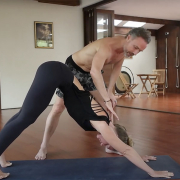 https://samahitaretreat.com/wp-content/uploads/2021/04/SAM_2698-scaled.jpg
1707
2560
Dr. Paul Dallaghan
http://samahitaretreat.com/wp-content/uploads/2024/01/samahita-logo-v2.svg
Dr. Paul Dallaghan2023-06-07 04:54:272024-02-15 09:46:19What is your state of mind? Perhaps yoga has some insight!
https://samahitaretreat.com/wp-content/uploads/2021/04/SAM_2698-scaled.jpg
1707
2560
Dr. Paul Dallaghan
http://samahitaretreat.com/wp-content/uploads/2024/01/samahita-logo-v2.svg
Dr. Paul Dallaghan2023-06-07 04:54:272024-02-15 09:46:19What is your state of mind? Perhaps yoga has some insight!Yoga & Working Out
Does yoga need cardio?
A yoga-asana practice is not a cardio workout regardless of breathwork incorporated into it. Yet the doing of cardio is beneficial in terms of one’s own overall health and fitness level. Thus, an additional focused functional aspect involving cardio is essential. Cycle at various speeds is one of the most optimal ways to include this. Moderation is key. We have up to two 30-minute cycle sessions a day. You may choose to do all of these or once every second day. Three times a week of shorter intense cardio, especially if not used to being active or older than 35, is a more healthy approach.
Does yoga need more core work?
Absolutely. Or rather your body needs more core work and original hatha yoga has highly emphasized the power of the core. Though a skillful practice of yoga asana will build the “core” region, a yogic core is one of primarily pelvic to spinal steadiness, very engaged work through the lower abdomen predominantly. It is often not quickly grasped by practitioners. To aid in the development of, and to add to, one’s core activity, a yoga practitioner can benefit greatly from core focused activity.
Is Yoga a workout or not?
Many practitioners approach yoga-asana under the banner of fitness but in terms of mere physical exercise, fitness and cardio benefits, yoga is much lower on the scale when compared to functional fitness and cycle activities. People practicing yoga can benefit from a short added period of increased activity that stimulates the metabolism, raising the heart rate and moving the body. Yoga, though also physically challenging at times, has a focus to balance nervous activity, teach integrity of posture, to encourage this through stamina development and holding of positions. Some positions are just too complex for the average person or too intricate to be added to a fitness routine, which current yoga approaches try to do. Traditional asana teaching highlights maintaining even breath, good heart rate, a subsequent autonomic nervous balance. Exercise and fitness promote the opposite. Both are good and both are needed. Here a practitioner can fully embrace and enjoy a workout with core and cardio activity while also benefitting tremendously from yoga asana practices that emphasize inner stability, balance, a supported body with freedom that is based on integrity of posture and mind.
What about yoga tradition?
Yoga tradition is not built on a physical set of practices, meaning an asana method. It is aiming to understand and then embody the principles of yoga which are part of the human experience in terms of our how we handle our relationships, how to manage the body and its metabolic processes, and to develop an attention on the internal aspects of life. Classical yoga tradition will define the nature of asana to be supported and free, done without irregular force yet a mind tuned to the breath and inner experience. This leaves open a myriad of ways to approach asana and how to sequence. Ironically, what is called traditional yoga today has actually grown out of hybrid influences from classical asana, European gymnastics, Indian traditional physical body methods, and even a good bit of early 20th century military style discipline. This is not tradition but just a passing method. Tradition honors the principles, which today we can say are understood and shown even scientifically as they endure across generations, but can still be adapted to changing social landscapes, both geopolitically and demographically. Tradition is based on intelligence not dogma. That intelligence is a clear mind and an open heart.
So, is yoga practice still evolving?
On a personal note, my life feels more balanced with a mixture of sitting, breathing, working on the body in asana, and getting a great functional fitness core strength and cardio workout. To engage in holistic activity for the whole person is not a luxury. It is a necessity. It is part of our living gracefully, aging well, and translates into our relationships and human interactions. No one has figured out how to optimally manage this human body in a whole life. Even with sagely advice and great gurus, it is all still a work-in-progress. Times are changing faster than any other period in known human history. Population levels are beyond anything previously experienced. We need to make some effort to get a handle on a life well lived, not just for the body, but for who we are in this world. One truth in the teaching is everything is in constant change. And so our approach to yoga practice must intelligently adapt to the needs of changing bodies, changing lifestyles, changing society, and even a degree of change in self-understanding.
This is why a full approach to body-mind-spirit is, and has to be, offered here. And what YogaCoreCycle is all about.
For a more detailed discussion around yoga and fitness please read the article Understand Yoga & Fitness
Dr. Paul Dallaghan’s expertise with breathwork, body and meditative practices comes from three sources: (1) three decades of daily dedicated practice and teaching these techniques; (2) uniquely acknowledged in the Yoga tradition by the title of “Master Yogi-Prānācharya (expert in breath)”, following an immersion in the original culture through one-on-one direct training in practice and study of ancient texts; (3) a PhD in doctoral scientific research at a leading US university (Emory) covering both the tradition and science of yoga and breath practices in terms of stress, health and aging. As a result, Paul occupies a unique space to impart genuine teaching and science on the breath, body, and meditative practices, seen as a Teacher-of-teachers and identified to carry on the tradition of Pranayama. His sincere and ongoing role is to teach, write and research, to help put out experienced and authentic information on these areas of how we live, breathe and be, to help people improve their mental and physical health, and live more fulfilling lives.
For more on his background see his bio
More from the Samahita Blog








